A Final Farewell to My Home Waters
Santa Cruz to Monterey
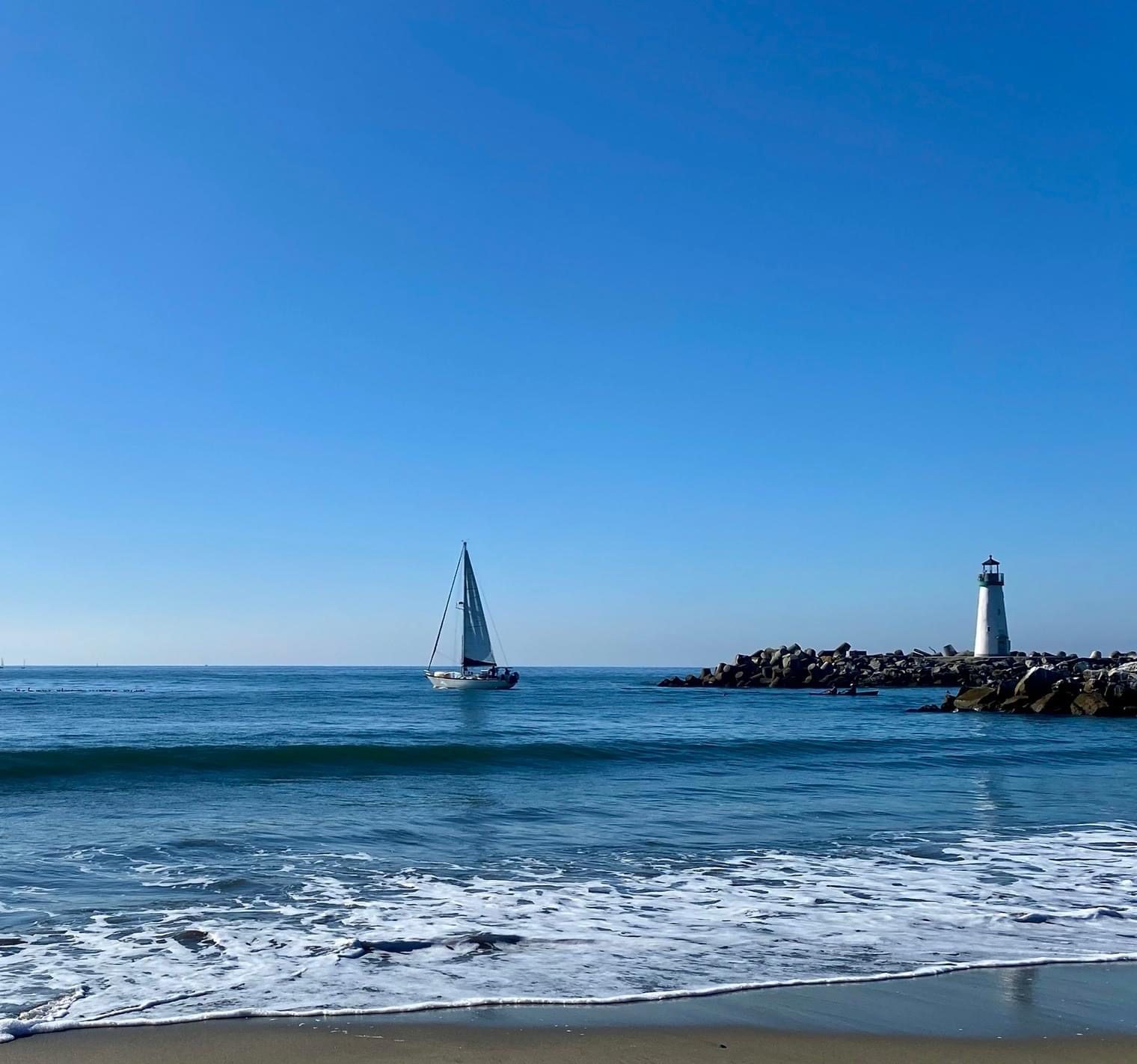
Photo of Avocet sailing out of Santa Cruz Harbor PC: Dad
It was November 18th and the autumn air had a bite to it, but it was bearable without the sharp lashings of wind – perhaps the only silver lining of having to motor. We had just left my home town of Santa Cruz and set our course for Monterey, the namesake of the bay we floated upon.
Monterey Bay is approximately 22 Miles across from Santa Cruz to Cypress Point, and is home to The Monterey Bay National Marine Sanctuary, one of the largest Marine Sanctuaries administered by the National Oceanic and Atmospheric Administration (NOAA), within the U.S. Department of Commerce. The Marine Sanctuary covers 6,094 square statute miles or 4,024 square nautical miles. At its center, there is an underwater canyon that is twice as deep as the Grand Canyon! The sanctuary provides habitat for 36 species of marine mammals, 94 species of seabirds, at least 525 species of fish, four of turtles, 31 phyla of invertebrates, and more than 450 species of marine algae – so it’s safe to say if you are spending time on the Monterey Bay you are bound to see some marine life.
The Anchorage
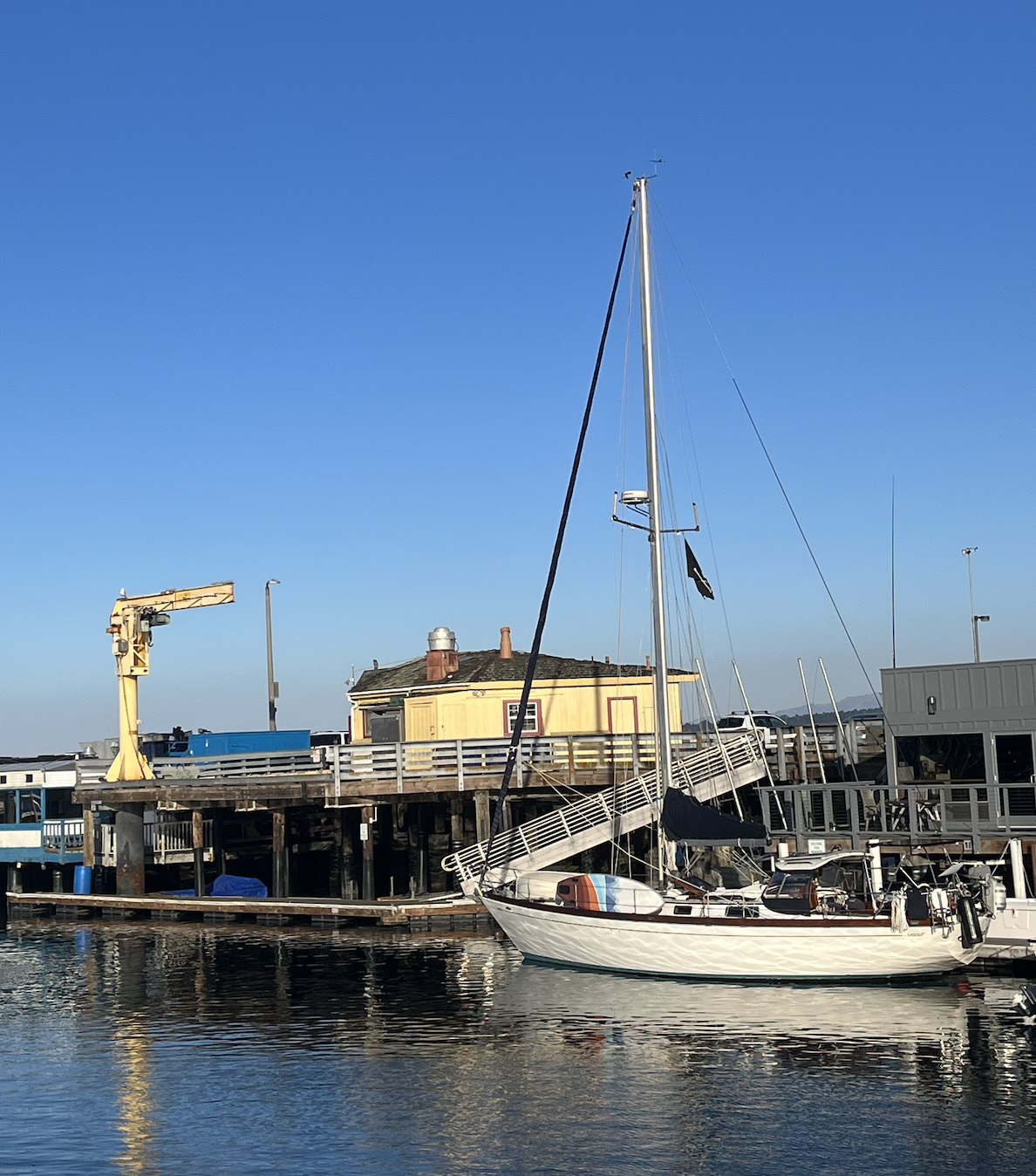
Thank you Monterey Peninsula Yacht Club!
After a long day of motoring we arrived at the anchorage just before sundown. The area east of Wharf II and the East Moorings is an open anchorage with excellent holding ground. Boats cannot be anchored here for more than 30 days in any six month period, but I wouldn’t recommend sticking around for long anyways. This anchorage is not well protected from any northern wind chop or swell – including the prevailing northwesterlies. However, unlike Santa Cruz it is well protected from the southerlies but given the fact it is wide open, it is reported to be a very rolly place to lay your hook. This spot is like any other roadstead anchorage and should not be taken as shelter in any foul weather. With warnings of a nearby wreck we laid our hook cautiously into the sandy seabed at 30’ with a 4:1 scope before settling in for the evening. Here are our anchor-drop coordinates 36°36.254’N * 121°53.155’W Fortunately the swell was in our favor and we barely rolled, and even when it did our FlopStopper countered the motions. It felt as serene as being in a marina but this would not be the case for the following day. (CONTACT THE MONTEREY HARBOR OFFICE AT 831-646-3950)
With the incoming northwesterly gale, we knew it would be best to seek actual shelter within the confines of the harbor. Luckily our friend Kevin from Shearwater Sailing helped us secure a reciprocal slip at the Monterey Peninsula Yacht Club for a few nights, giving us easy access to the main attractions in Monterey, including the world renowned aquarium.
Worth noting that this yacht club had very clean facilities including water, electrical hook ups, onshore bathrooms, showers and club house that had happy hour – unsure about laundry, we never asked!
The Monterey Bay Aquarium
Known for its regional focus on the marine habitats of Monterey Bay, the Monterey Bay Aquarium was the first to exhibit a living kelp forest when it opened in October 1984. Its biologists have pioneered the animal husbandry of jellyfish and it was the first to successfully care for and display a great white shark – for a little while anyways… it ended up eating all the other fish once it was an adult. The organization’s research and conservation efforts also focus on sea otters, various birds, and tunas. Seafood Watch, a sustainable seafood advisory list published by the aquarium beginning in 1999, has influenced the discussion surrounding sustainable seafood – a bit ironic since the aquarium is built on a defunct sardine cannery!
When I was a kid my family owned season passes to the aquarium, which meant we went quite often. However, despite our frequent attendance my parents used to blow through the entire thing not really savoring the moments and actually reading about what fish swam within the impressive tanks. As an independent adult I had the opportunity to chart my own destiny and set up camp in front of whatever tanks I wanted for however long I wanted, letting the species within mesmerize me to my core. I was rewarded with watching the divers feed the skates, and even hear how every morning someone has to untangle the jellyfish tentacles – a silly but necessary job. Speaking of, a favorite exhibit between Chris and I was the jellyfish exhibits where we once again got close and personal with the Pacific Nettles that we had a run in with in the wild coming down the coast.
It was a beautiful, warm, day in Monterey and although we appreciated every exhibit the aquarium had to offer we desperately wanted to be outdoors so made our final rounds and departed to begin our quest for the best clam chowder. Truth be told, despite my coastal upbringing I have never actually enjoyed seafood. Up until recently I couldn’t even stomach clam chowder, but sometimes, when the mood is right and location is appropriate I will order a bowl – at least that was the case when we sat down for lunch at Fisherman’s Grotto on the wharf.
The Monterey Wharf is an old fishing pier along the Monterey Bay. Originally built in 1846 for passenger and freight ships, it turned into a commercial fishing pier by the 1900s. Shortly after World War II, the overfished sardines in the area began to disappear and the fishing industry collapsed.
“Anything else?” Our waiter asked as he cleared the table. Sticker shocked by the menu prices we thanked him and asked for the check, already struggling to grapple with the fact that two bowls of soup somehow equated to $36. But that’s Monterey for you: pricey, pricey, pricey.
We had just returned to Avocet when Kevin texted me. He was returning back from his day-charter and saw a dead whale at the harbor entrance, which (according to his text) was well within dinghy distance. Together, Chris and I launched Winglet and made our way out of the breakwater to investigate the creature that I identified as a juvenile Fin whale – and a very dead one at that.
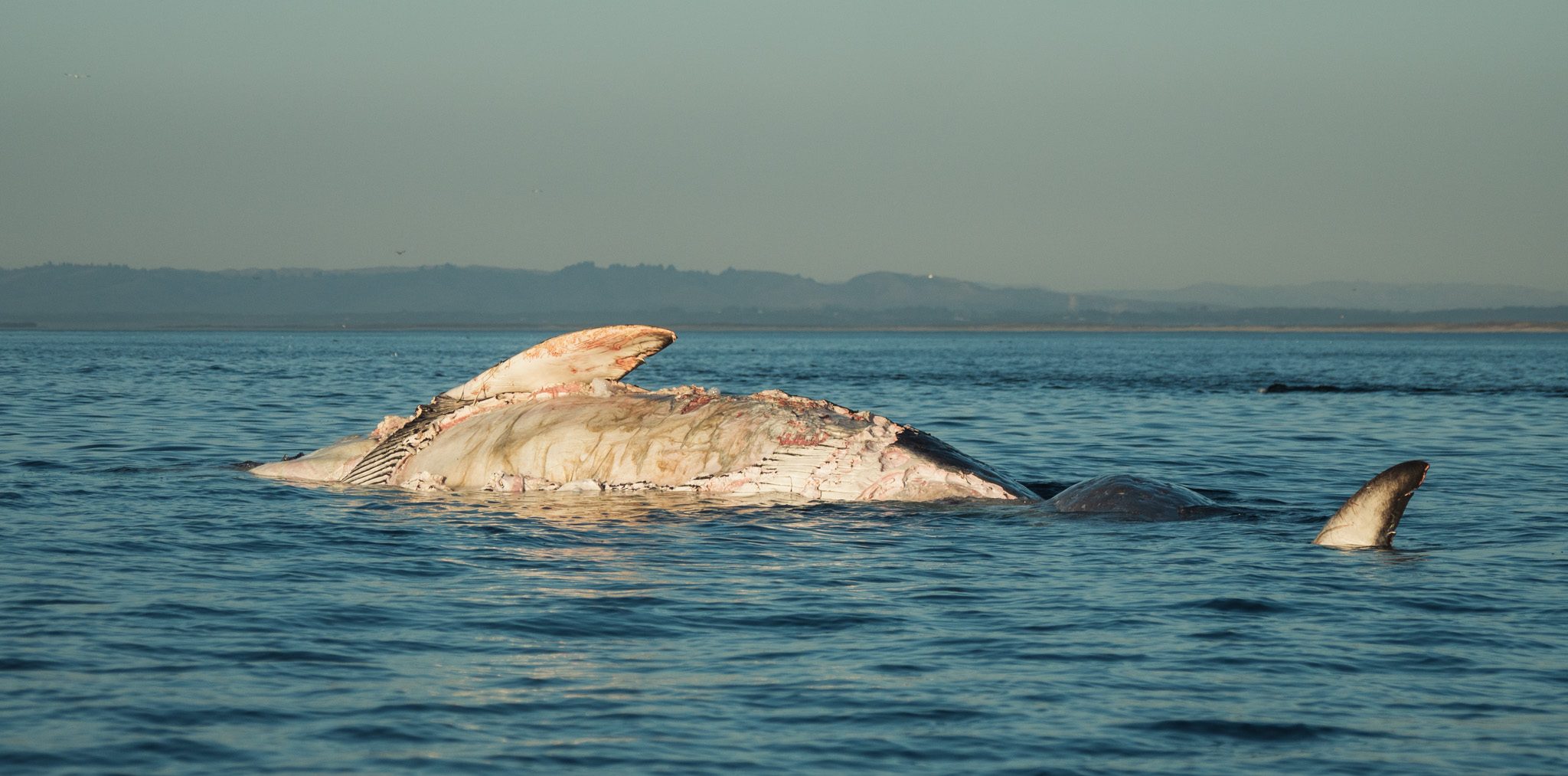
RIP Fin Whale
The Fin whale is the second-largest whale species on earth, second only to the blue whale. It is found throughout the world’s oceans, but considering they are deep water mammals a near coastal spotting is considered rare. Although they are the fastest of all great whales capable of swimming up to 23 miles per hour, they couldn’t outrun commercial whalers when the industry modernized with steam-powered ships and explosive harpoons, killing a huge number during the mid-1900s—nearly 725,000 in the Southern Hemisphere alone. They are still an endangered species in the northern hemisphere, so seeing one, even after its expiration, was an experience.
The whale was lined with impressive bite marks, exposing blubber all around. Half its tailfin floated above the surface with scars running the length of it. Upwind there was no smell but the moment Chris moved us behind to take a peek it was atrocious. We sat by the whale, patiently waiting to see if any white sharks would come by for a taste but unfortunately the coast guard arrived before the apex predators and we decided to bugger off to let the Coasties do their thing.
Biking, Boats and Brews
Chris and I like to bring our mountain bikes out every chance we get, so when we woke up to a beautiful blue sky and clear schedule, we took to the trail and made our way to Lovers Point. The Monterey Bay Coastal Recreation Trail stretches 18 miles, from Castroville in the north to Pacific Grove in the south. This long, scenic paved path hugs the coastline, following the same route as the old Southern Pacific Railway and is a great way to reach the Monterey Bay Aquarium, Cannery Row, the American Tin Cannery shopping and outlet mall, Fisherman’s Wharf, and much more – avoiding busy roads and parking hassles.
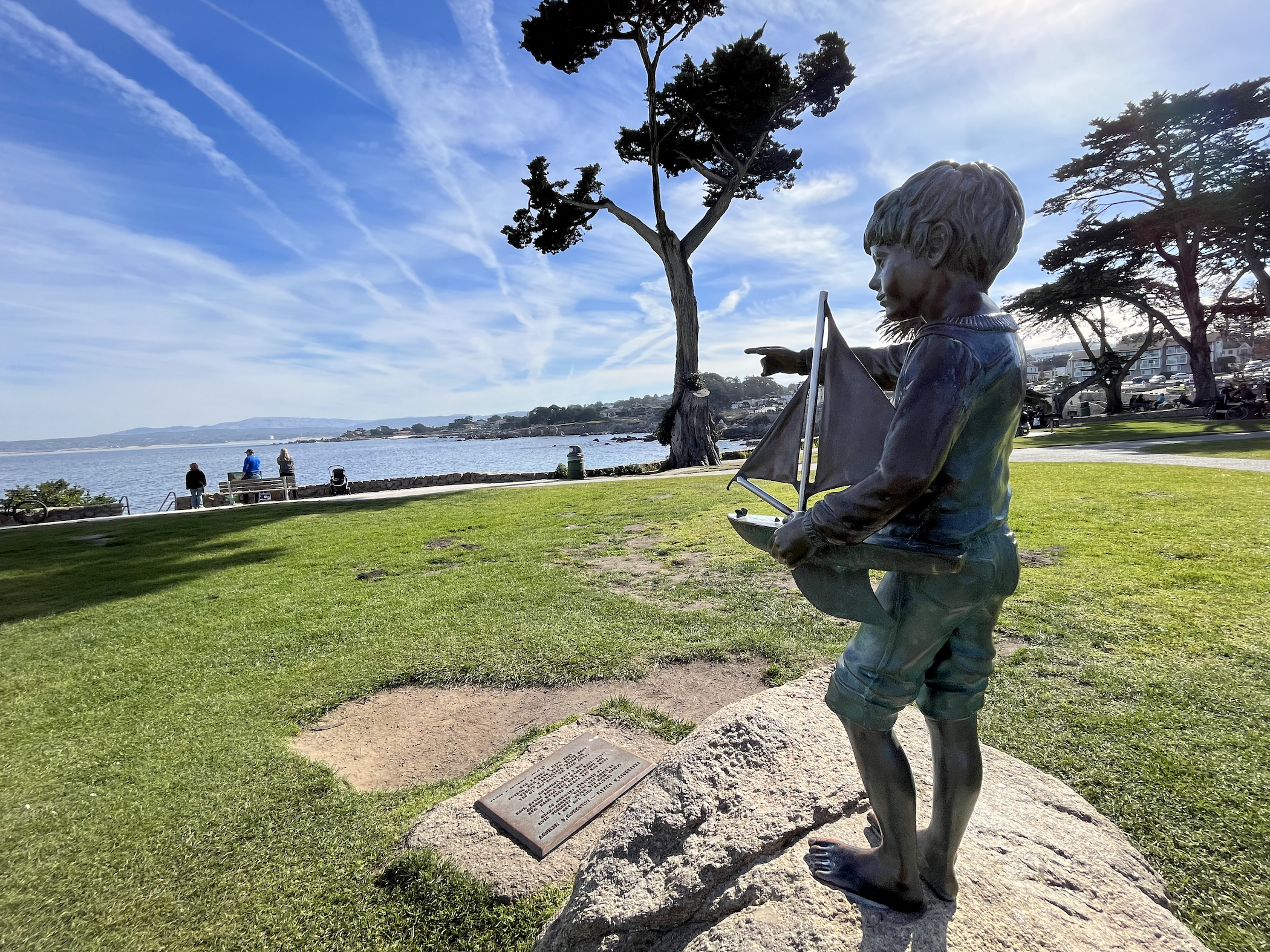 Luckily the trail ran beside the Monterey Boatworks Boatyard, which was open, so we could browse the chandlery for some new parts. Somewhere in between our travels we broke our main sheet block and needed a simple replacement. Although many members at the yacht club swore the chancellery had nothing useful in stock, it had exactly what we needed unlike the tiny West Marine that we checked out the day prior. With new parts in our bag we continued on our ride, passing by families pushing little ones in strollers, casual walkers, joggers, fellow bikers and the occasional dog on a walk.
Luckily the trail ran beside the Monterey Boatworks Boatyard, which was open, so we could browse the chandlery for some new parts. Somewhere in between our travels we broke our main sheet block and needed a simple replacement. Although many members at the yacht club swore the chancellery had nothing useful in stock, it had exactly what we needed unlike the tiny West Marine that we checked out the day prior. With new parts in our bag we continued on our ride, passing by families pushing little ones in strollers, casual walkers, joggers, fellow bikers and the occasional dog on a walk.
At Lovers Point we took to the sand, ditching our shoes to feel the grainy earth between our toes and investigated the nearby tide pools. I put our GoPro in a pool full of snails and hermit crabs to capture their movement when suddenly a little shore crab hooked the camera with its legs and tried to pull it into its lair beneath the rock it resided. We laughed as the little creature struggled to pull the camera in, realizing it probably saw its reflection in the monitor and wanted to fight. I could watch the ebb and flow of water through the tide pools for hours, but we had a lunch date to attend so we dusted the sand off our feet, put our shoes back on and made our way back into Old Monterey.
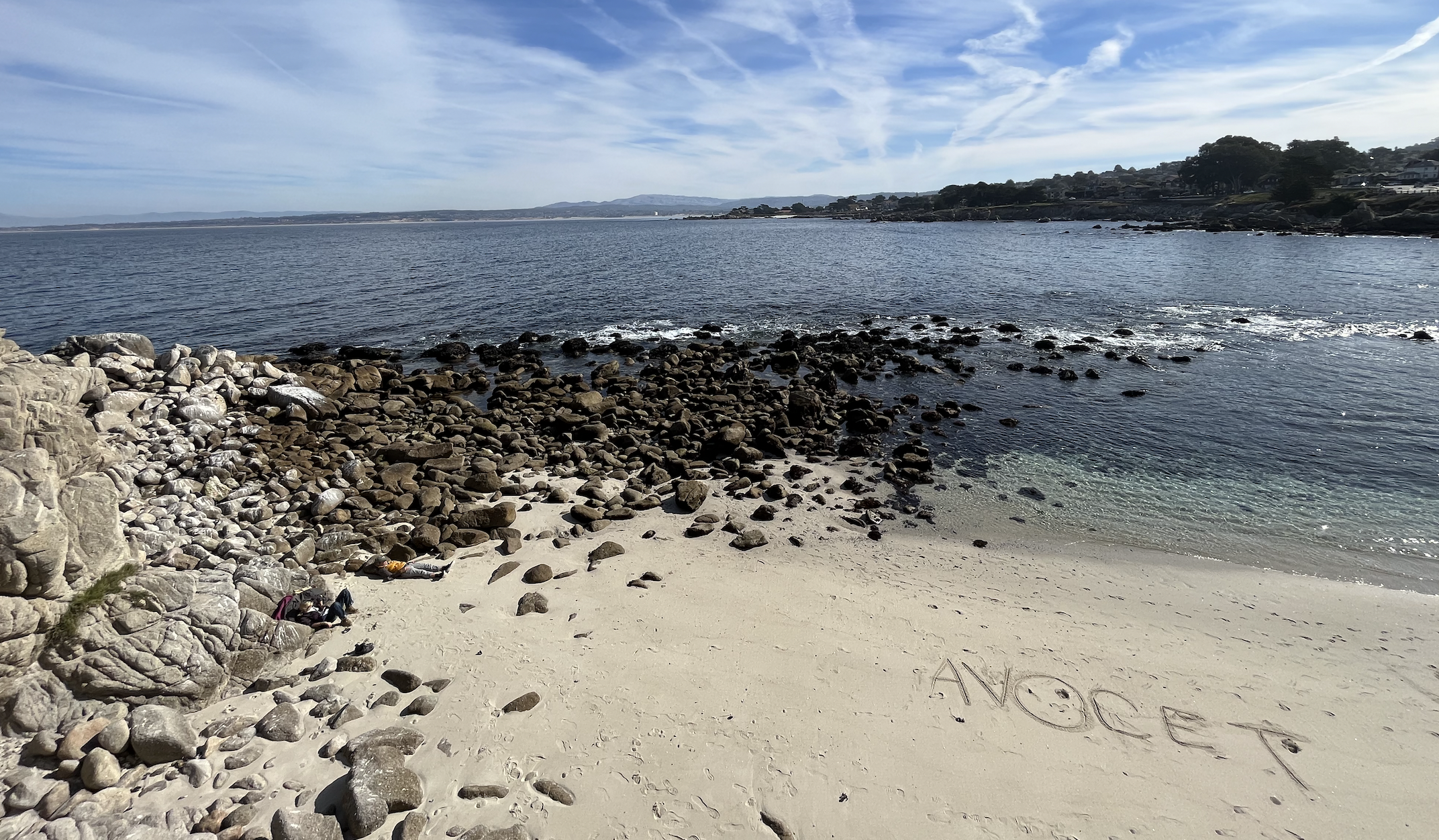
Leaving our mark in the sand at Lovers Beach
“Good to see you again” Kevin said as we locked our bikes to a tree. He kindly invited us to lunch to discuss boats, plans, and all the things in between. It was wonderful to hear how passionate he is about sailing and educating by doing, offering offshore charters along the California coast in addition to his day charters out of Monterey – but of course my favorite part of the conversation was hearing how Kevin came to create his business, Shearwater Sailing, and how much he loves his boat, Atalanta.
After an early sailing and racing career in California, Europe and the Caribbean, Kevin had adopted a conventional job but was eager to return to the water and the year 2020 gave him that opportunity. During the depths of the Covid pandemic disruption, he hatched a plan to create a new sailing charter business based on the West Coast, which would provide both local sailing trips on Monterey Bay as well as offshore adventures along the coast and across the Pacific Ocean. But you can’t have a charter business without a boat, so in comes Atalanta.
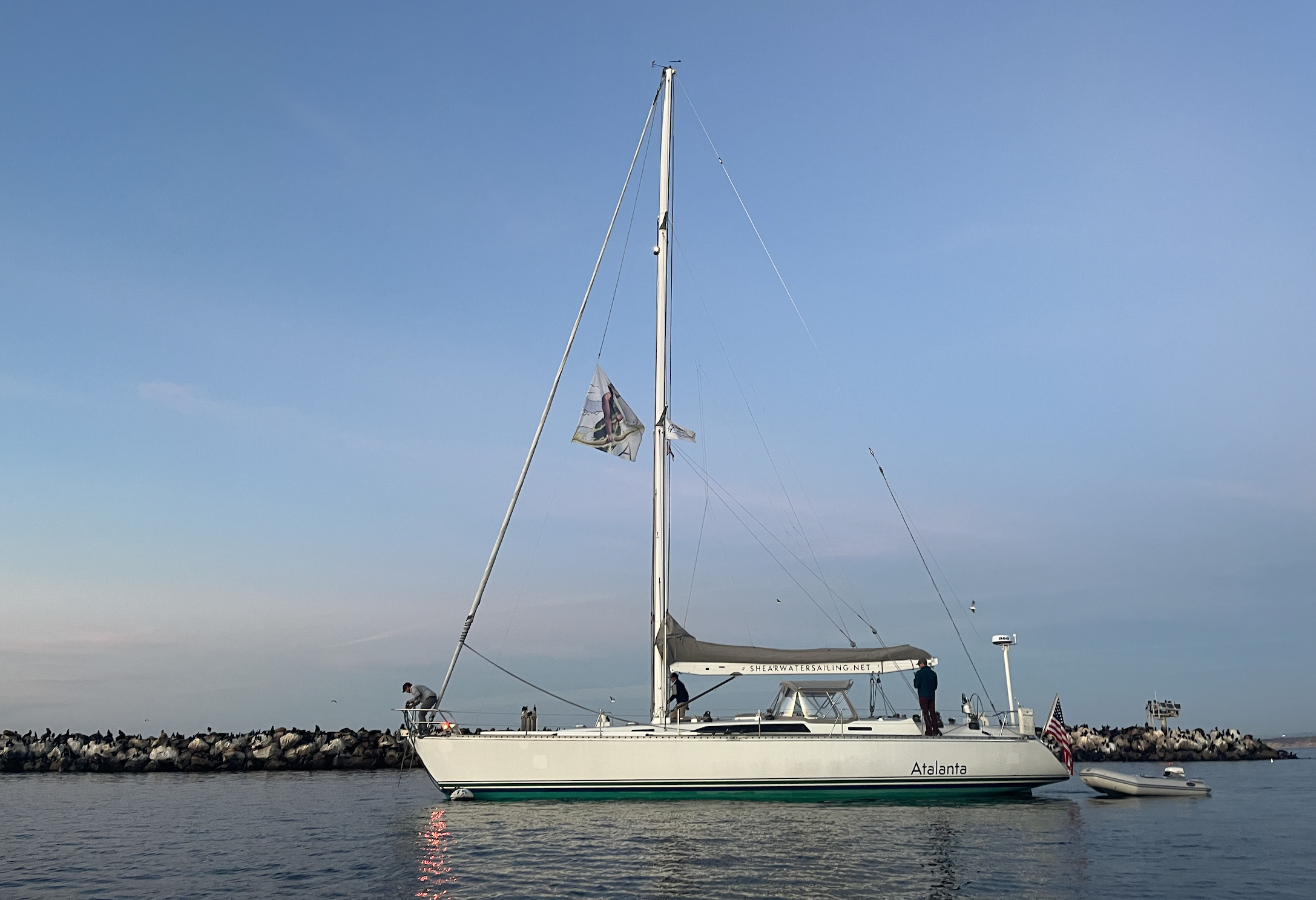
Atalanta at her mooring with Kevin, Chris and Scott aboard
In 1988, New Zealand’s storied McGaffin Brothers Boatyard was commissioned to build Design 154 from one of the world’s leading naval architecture firms, Farr Yacht Design. The design brief called for a strongly constructed yacht capable of sailing comfortably in high-latitudes, with an excellent turn of speed and a luxurious interior hand-crafted of Tawa, a prized New Zealand hardwood. Upon completion, Atalanta was shipped to her new home in Annapolis. She then voyaged through the Caribbean, transited the Panama Canal, and sailed north to San Francisco Bay, where between trips to Mexico she occupied a prime slip in front of the St. Francis Yacht Club for the next 20 years.
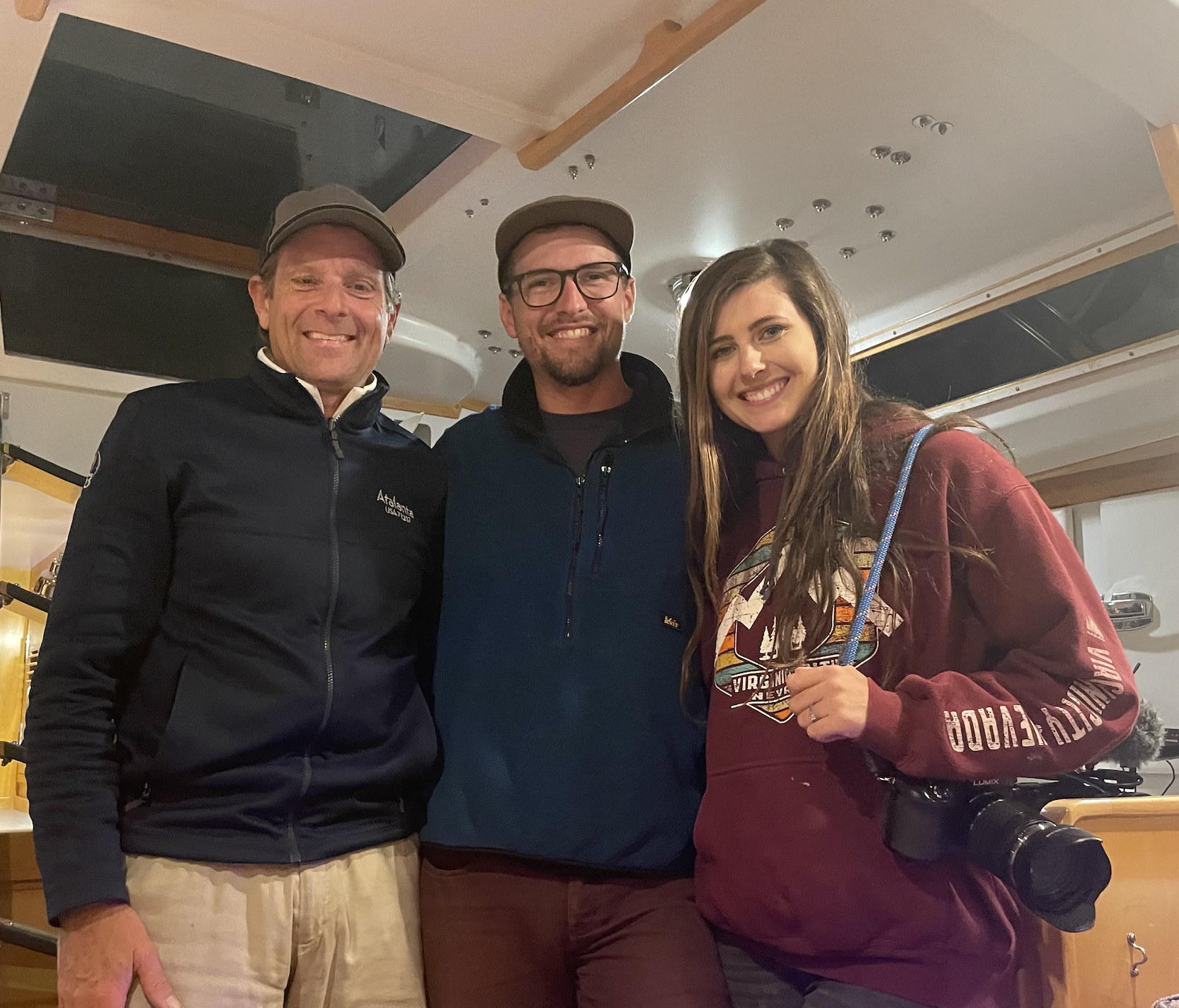
Thank you for everything Kevin! OC: Scott Watkins
In 2020, Kevin acquired Atalanta and undertook a major restoration, upgrading and replacing nearly all of the boat’s systems: rigging, hydraulics, windows, canvas, electrical, lifelines, electronics, rudder bearing, steering systems and deck hardware. In our opinion, the best way to get acquainted with your boat is to tear her apart and build her back up again! At 38,000 pounds, Atalanta rides through the ocean without pounding, but is still significantly lighter and more nimble than many cruising yachts her size. She is right at home on Monterey Bay and is now the beautiful and proud flagship of Shearwater Sailing.
Chris and I enjoyed hearing abot Kevin’s love for sailing and Atalanta’s history over a wonderful lunch and were so pleased to have the honor to step aboard and interview Kevin for an upcoming YouTube video. It was a great bonus to visit with an old family friend, Scott, who happens to crew with Kevin from time to time as well!
17 Mile Drive
During our last full day in Monterey we did something pretty special with my parents, who made the drive down from Santa Cruz to see us off one last time. From his Baja Bug as a teenager to his green flag Porsche racing days at Laguna Seca, my dad has always been into cars leading up to his decision to pull the trigger on a Lotus Elise (then later Evora) to replace the Porche Carrera that was the queen of our garage for years. According to my dad, the Lotus requires less maintenance, has more creature comforts, and is way more responsive and fun to drive. Plus it fits right in at Pebble Beach where my parents frequent for the occasional weekend getaway.
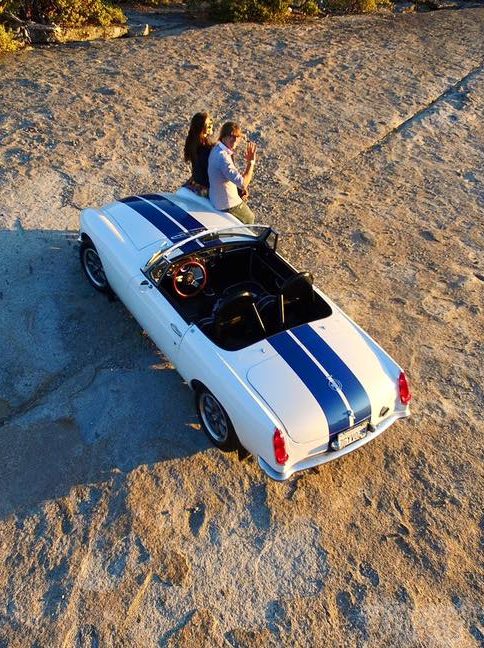
15 Year old Chris, Marissa and the MG
Similar to my dad, Chris has somewhat always been a car guy, or at least has a deeper appreciation for cars after building his 1963 MGB from the frame up as a 14 year old. Because of this, my dad agreed to let his favorite son in law drive the Lotus along part of 17 mile drive – after a little convincing of course.
17-Mile Drive is a scenic road through Pebble Beach and Pacific Grove on the Monterey Peninsula, much of which hugs the Pacific coastline. The drive is iconic and enchanting, full of dramatic coastal cliffs, snow-white beaches, legendary golf courses, mansions and scenic attractions, including Bird Rock, the 5,300-acre Del Monte Forest of Monterey Cypress trees and, of course, the Lone Cypress.
“I don’t get it…” Chris said beneath his breath. Sworms of photo happy tourists buzzed around us, fighting to get the best photo of the Cyprus Tree that grew in solitude with a striking sea background – also known as, the Lone Cyprus. I did my best to explain why the tree was such a big deal, but despite my efforts all Chris saw was a very sad looking tree, being held together by wires and other rigs after storms tried to tear it limb from limb.
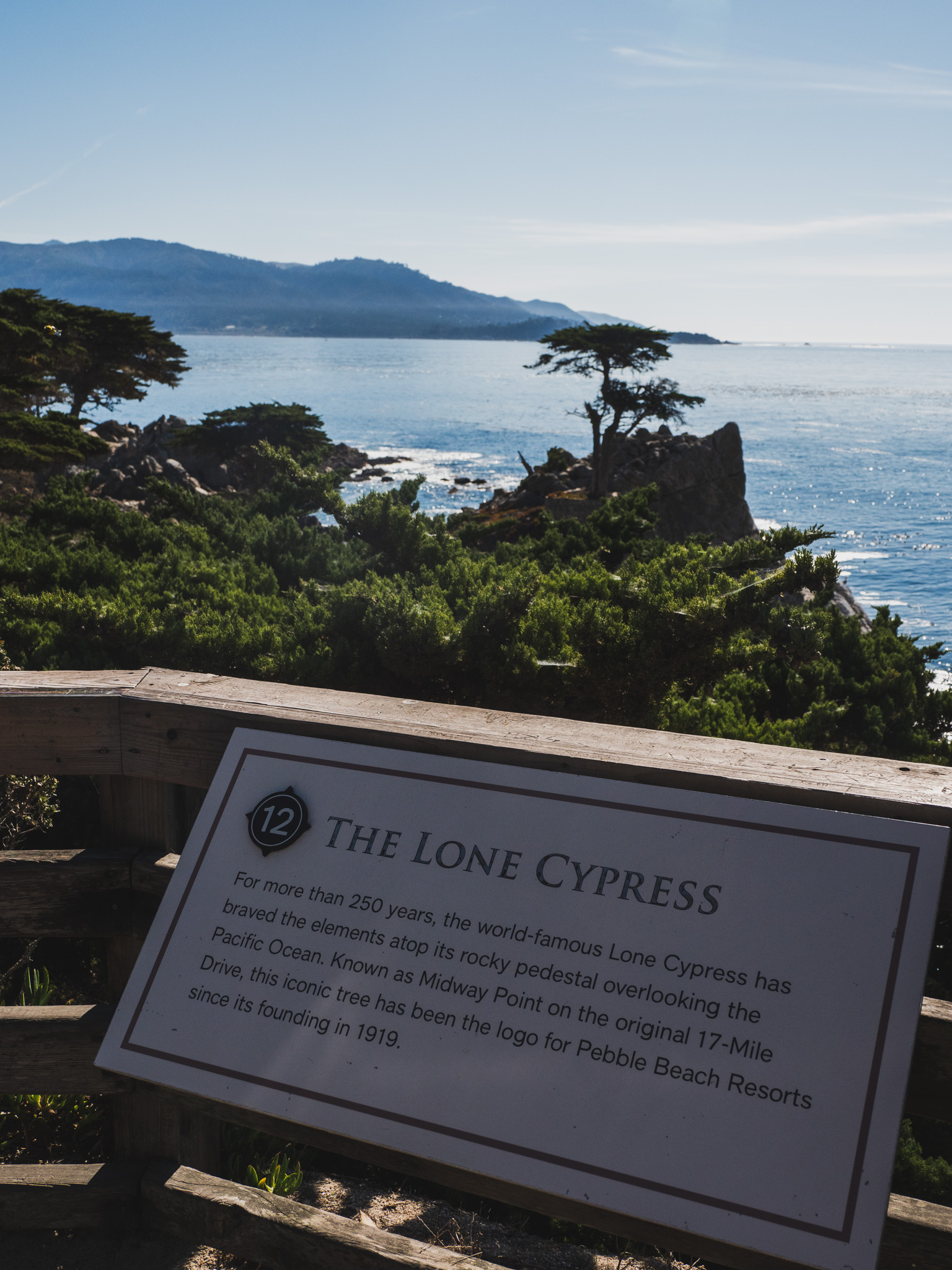
The Lone Cyprus
To boil it down: The Lone Cypress is a Monterey cypress tree that stands atop a granite headland overlooking Carmel Bay, the tree has become a Western icon and has been called one of the most photographed trees in North America. As legend has it, the tree is believed to have been seeded circa 1750 in what was then the Spanish colony of New Spain. However, the precise age of the tree is unknown and can only be inferred. A drawing of the tree was registered as Pebble Beach Company’s trademark in 1919, which according to the company, protects not only the logo but also the tree itself.
It was around here my dad took his keys back and we all drove to the Pebble Beach Lodge for lunch at The Bench, which looks out over the 18th hole. Of course this lunch was an investment given the location, but it was delicious and we cannot recommend the Portobello Fries enough – they were to die for! It was a wonderful way to spend our final moments in Monterey.
Chris and I felt out of our leage in Monterey with our “yacht” residing at the yacht club, and taking a casual drive in the Lotus to Pebble Beach Lodge for lunch on a Thursday – but rest assured, we are still the salty, hard working boat kids you have come to know and love. So salty, in fact, that after a final paddle around the harbor on our SUP’s, a man offered to open the club up for us so we could use the showers.
After some light conversation we learned that he was none other than Jefferey Canepa, who used to produce the Ultimate 20. “So who likes cruising more, you or Chris?” he asked as I gathered our shower bag. “I think we enjoy it the same, because we are in it together” I said, looking to Chris for any input. A tough question, but after a nod of agreeance, I was confident in my answer. However, it is truly amazing how our “love of cruising” bliss could so quickly be turned into a moment of questioning our desicions, and sanity on the day of our departure.
The Departure From Hell
That dreadful day started like any other departure; we had started up the engine with no issues, untied from the dock, and made our way out to the ocean. Right out of the Monterey Harbor breakwater the engine revved loud and quick, a hiccup, which we thought was our prop getting caught on kelp – which was not uncommon for the area. Moments later when we were about to raise our main the diesel revved higher than before and kept increasing, blowing billows of white and gray smoke off our stern. I grabbed the helm and Chris dashed below deck, the two of us simultaneously understanding the direness of the situation.
I was eternally grateful for the small seas and gentle breeze, easing the tension ever so slightly allowing Chris to throw open the floorboards to reveal our angry engine, assess the issue and quickly find a resolution. In the span of 60 seconds Chris tried to stop the engine first by manually actuating stop cylinoid on the high pressure pump, but was unsuccessful. He then knew for sure it was a runaway, having nothing to do with the fuel system. The only way he could shut down the engine was to starve it from oxygen. I watched from above as he grabbed a screwdriver to remove the mushroom filter, throwing it to the side as he threw his palm over the intake.
You could cut the tension with a butter knife. I continued to sail on course while Chris scrambled in and out of the boat, repeating the same swears as if he were trying to sumon a creature from the deep. Oil was everywhere, adding a black layer atop of our varnished surfaces and displayed on Chris’s arms and face like war paint.
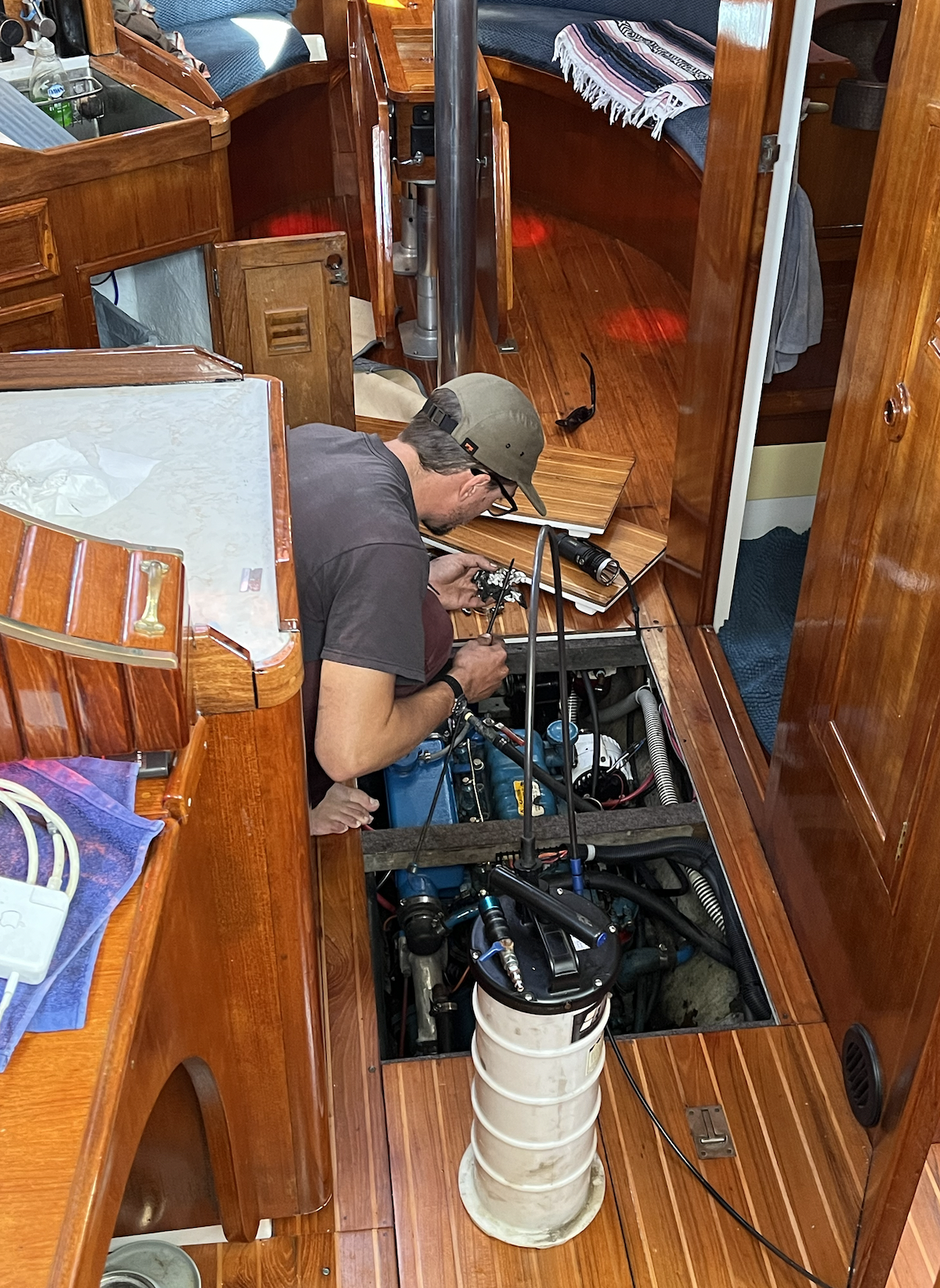
Chris troubleshooting after the engine shut off
With our floorboards tossed aside and engine fully exposed like a heart surgery patient, Chris was able to conclude that the amount of oil inside the oil sump was much too high, resulting in the oil surpassing the pistons when we healed over, being brought up into the intake manifold… at this point the oil wasnt just oil anymore either, it was mostly diesel, creating the perfect recipe for a runaway.
In short, a runaway diesel is exactly what it sounds like: a diesel engine that just won’t stop, resulting in a cascade of problems, such as damages, injury or worse – the loss of your boat or death, which to some may be one in the same.
Chris grabbed our oil siphon and began to remove about a gallon of oil mixed diesel out of the engine, returning the level back to normal on the dipstick. He then carefully inspected the block and the sump beneath the engine to ensure no rods were thrown or any other damages were apparent. Usually, in a runaway incident its more than likely that a connecting rod will be thrown through the side of the engine rendering it totaled. Luckily, Chris caught the Perkins before any major damage was done. After we assessed and concluded that the engine was still intact, we decided to continue on with our passage – especially since wind was forecasted and we had sails to get us to our next port, Morro Bay.
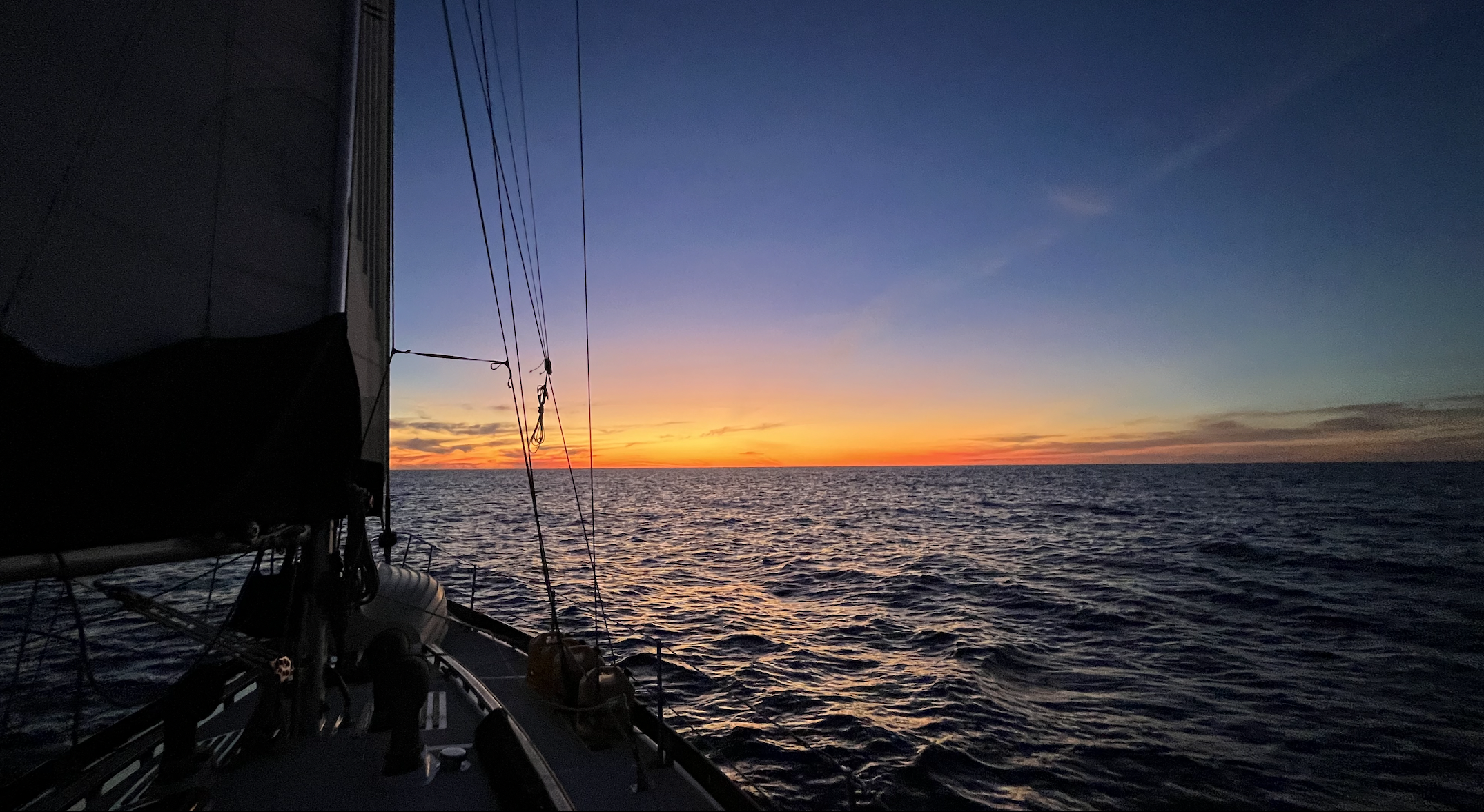
The calm before the chaos
It was a long night full of steady winds and 8 – 12 foot following swell, pushing Avocet down the California coast at speeds she had seldom seen before – setting a new personal hull speed of 12.9 knots! Although the speed was exhilarating it was definitely one of the most aggressive night passages we have made… complete with a grey whale slapping its tail less than 50 yards from us as a warning. If only we knew what awaited us in the near future. But that is a story for another time, so stay tuned!
Sending you love and fair winds,
Marissa (and Chris and Cleo)
(Happily posting from Mainland MX)
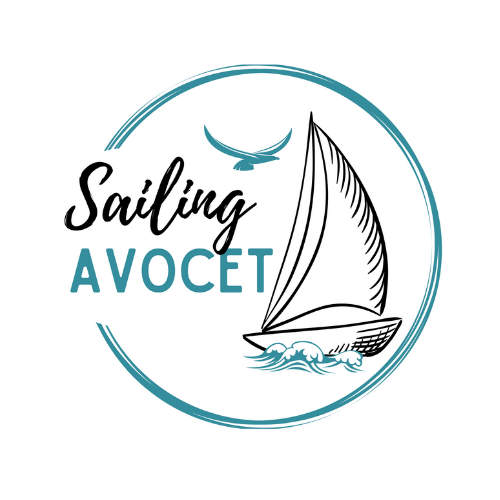


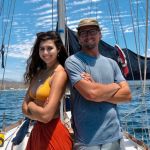

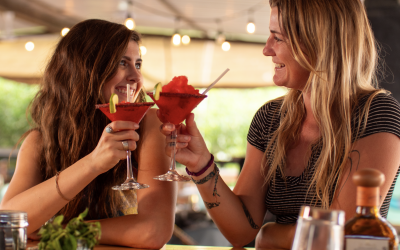

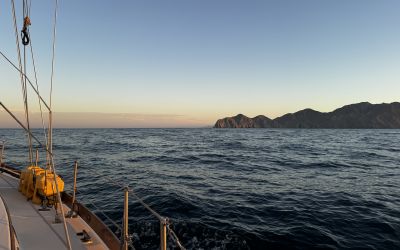
0 Comments